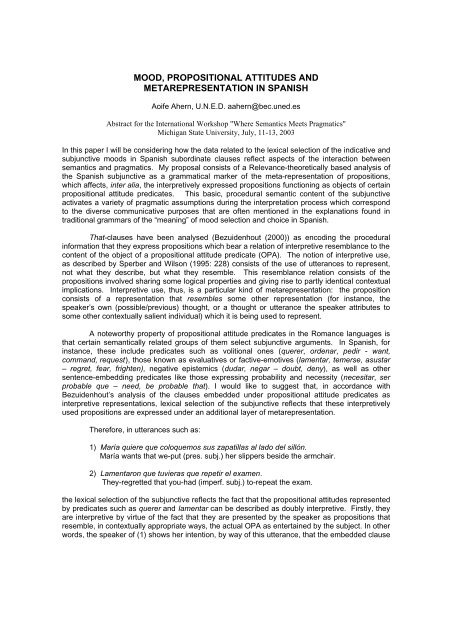SemPrag03.Progr.pdf - Institut für Linguistik/Germanistik - Universität ...
SemPrag03.Progr.pdf - Institut für Linguistik/Germanistik - Universität ...
SemPrag03.Progr.pdf - Institut für Linguistik/Germanistik - Universität ...
You also want an ePaper? Increase the reach of your titles
YUMPU automatically turns print PDFs into web optimized ePapers that Google loves.
MOOD, PROPOSITIONAL ATTITUDES AND<br />
METAREPRESENTATION IN SPANISH<br />
Aoife Ahern, U.N.E.D. aahern@bec.uned.es<br />
Abstract for the International Workshop "Where Semantics Meets Pragmatics"<br />
Michigan State University, July, 11-13, 2003<br />
In this paper I will be considering how the data related to the lexical selection of the indicative and<br />
subjunctive moods in Spanish subordinate clauses reflect aspects of the interaction between<br />
semantics and pragmatics. My proposal consists of a Relevance-theoretically based analysis of<br />
the Spanish subjunctive as a grammatical marker of the meta-representation of propositions,<br />
which affects, inter alia, the interpretively expressed propositions functioning as objects of certain<br />
propositional attitude predicates. This basic, procedural semantic content of the subjunctive<br />
activates a variety of pragmatic assumptions during the interpretation process which correspond<br />
to the diverse communicative purposes that are often mentioned in the explanations found in<br />
traditional grammars of the “meaning” of mood selection and choice in Spanish.<br />
That-clauses have been analysed (Bezuidenhout (2000)) as encoding the procedural<br />
information that they express propositions which bear a relation of interpretive resemblance to the<br />
content of the object of a propositional attitude predicate (OPA). The notion of interpretive use,<br />
as described by Sperber and Wilson (1995: 228) consists of the use of utterances to represent,<br />
not what they describe, but what they resemble. This resemblance relation consists of the<br />
propositions involved sharing some logical properties and giving rise to partly identical contextual<br />
implications. Interpretive use, thus, is a particular kind of metarepresentation: the proposition<br />
consists of a representation that resembles some other representation (for instance, the<br />
speaker’s own (possible/previous) thought, or a thought or utterance the speaker attributes to<br />
some other contextually salient individual) which it is being used to represent.<br />
A noteworthy property of propositional attitude predicates in the Romance languages is<br />
that certain semantically related groups of them select subjunctive arguments. In Spanish, for<br />
instance, these include predicates such as volitional ones (querer, ordenar, pedir - want,<br />
command, request), those known as evaluatives or factive-emotives (lamentar, temerse, asustar<br />
– regret, fear, frighten), negative epistemics (dudar, negar – doubt, deny), as well as other<br />
sentence-embedding predicates like those expressing probability and necessity (necesitar, ser<br />
probable que – need, be probable that). I would like to suggest that, in accordance with<br />
Bezuidenhout’s analysis of the clauses embedded under propositional attitude predicates as<br />
interpretive representations, lexical selection of the subjunctive reflects that these interpretively<br />
used propositions are expressed under an additional layer of metarepresentation.<br />
Therefore, in utterances such as:<br />
1) María quiere que coloquemos sus zapatillas al lado del sillón.<br />
María wants that we-put (pres. subj.) her slippers beside the armchair.<br />
2) Lamentaron que tuvieras que repetir el examen.<br />
They-regretted that you-had (imperf. subj.) to-repeat the exam.<br />
the lexical selection of the subjunctive reflects the fact that the propositional attitudes represented<br />
by predicates such as querer and lamentar can be described as doubly interpretive. Firstly, they<br />
are interpretive by virtue of the fact that they are presented by the speaker as propositions that<br />
resemble, in contextually appropriate ways, the actual OPA as entertained by the subject. In other<br />
words, the speaker of (1) shows her intention, by way of this utterance, that the embedded clause

















